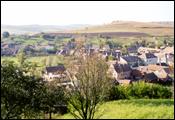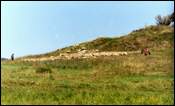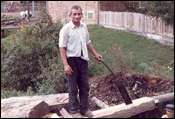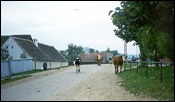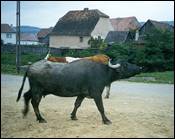|
|
View
of the Village
Vurpar is a necklace of red tiled roofs strung between the
Romanian and German churches. Some 2,400 people live in
Vurpar, mostly Romanians, Gypsies and Germans. The economy
in Vurpar is rural, agrarian, and facilitated through barter.
|
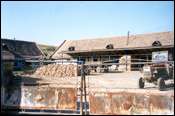 |
Former
Kolhoz
The communists tried to collectivize the farms on the Soviet
Kolhoz model. At the same time they industrialized the cities
installing great steam belching steel works, foundries and
factories. Young people left the villages for the higher pay
of the cities. The factories failed, the collectives failed.
Communism failed. The cities are now filled with the unemployed.
The villagers, who were taught by the communists to depend
upon central planning, have no supplies, no spare parts, no
income, no markets, and no idea where to start (How
to Help). It is quite a challenge to rebuild farms, develop
markets and compete with the significantly more efficient
West, without outside help. |
|
|
Sheep
Flock
For hundreds of years the sheep have grazed in the fields
around Vurpar and they still produce food for the village
and some income for their owners. They are one of the few
aspects of local agricultural that has not totally failed.
|
|
|
Sawing
Logs
The entire economy has been disrupted to the point where
power tools are almost unheard of. Labor in the village
is more reminiscent of the 19th century. (How
to help.)
|
|
|
'Til
the Cows Come Home
In the morning the cows leave their courtyards and head
toward pasture and food. They graze in the sun and rain
and come home, leaderless it seems, at the dusk of each
day to be milked and to find shelter. They go to "their"
gate, nudge it open or are met by a member of the household.
Being "out until the cows come home" has a clearer meaning
in Vurpar. It's not all that late.
|
|
|
The
Pasture Road
Life has a rhythm in Vurpar. Cows use the streets like the
humans and it all seems well ordered and normal. The cows
(oxen and horses, too) move with purpose from one place to
another as if they have obligations to fulfill. Most families
have a cow, a pig, chickens and a garden. That's how they
get by. |
|
|
Water
Buffalo
Water Buffalo are big animals and they do their work in the
village, too. They are important for carrying materials and
for plowing. You occasionally see a buffalo plying in the
streets on the way to somewhere and something. |
|
|
Home
The center of each home is the dining room table. Most homes
in Vurpar are small, having one bedroom, a kitchen, and a
dining room. A few have a living room that serves as an additional
bedroom. Fewer still have an indoor bathroom. |
Next
Page
Make
donations payable to:
Vurpar
Project, St. Mary's Romanian Orthodox Church,
% Jim Sack
902
West Rudisill Blvd,
Fort Wayne, IN 46807.
It's
a tax deductible donation!
|


